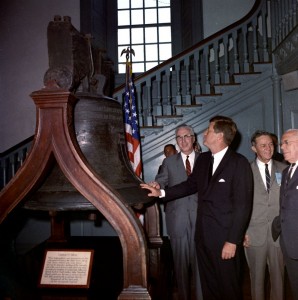
Photo credit “Cecil Stoughton. White House Photographs. John F. Kennedy Presidential Library and Museum, Boston”
John F. Kennedy is one of the most profiled figures in American history. The democratic president was in control of the country during some of the most stress-inducing periods in the history of the United States. Amid domestic issues such as tensions of racial injustice to foreign conflicts like threats of nuclear warfare from the events of the Cuban Missile Crisis, Kennedy’s presidency was certainly one for the ages. The youngest elected president (at age 43) had captured the charm of Americans with his distinct voice, savvy speeches and presentation of the beautiful first family. However, nearly three years after being sworn into office, JFK was assassinated in Dallas, Texas as he sat alongside his wife, Jacqueline, in his motorcade as they drove past Dealey Plaza. November 22, 1963 will forever be remembered as the day John F. Kennedy was assassinated. In other words, that day would also be remembered as the day that the American people lost their “Camelot.”
Now, you’re probably wondering how a former president of the United States can be compared to the story of King Arthur and his dreams of a “utopian kingdom.” First of all, the story of Camelot was of King Arthur’s vision of ruling his kingdom free of violence and despair and relying on the virtues of equality and perfection to ensure better living qualities for the people of Camelot (Brigance 3). Linda Brigance wrote in her article, For One Brief Shining Moment: Choosing to Remember Camelot, about the myth of the icon JFK and how it is perpetuated by those who remember him as much as what he did while he was alive. Following his assassination, the nation was in shock over losing not only a powerful figure but also a man who they believed was their saving grace for the future. Brigance states, “The Camelot myth and its identification with Old World notions of royal lineage had just the script Americans needed,” (Brigance 5). Basically, by focusing on the great things that made the people have faith in Kennedy and honoring him as if he were royalty, Americans’ fear in the wake of the assassination could slowly fade away. Brigance also mentions how subsequent members of the Kennedy family like Robert Kennedy and Edward Kennedy were seen as the heirs to the “throne” of JFK and to also further the legacy of Camelot (Brigance 6).
However, it mostly seems as though the adoption of Camelot with his association with the Kennedy family was more of a product of Americans suppressing the negativity of Kennedy’s assassination while living in a new kind of world after November 22, 1963. The story of Camelot is a nice way to immortalize and iconize John Kennedy. Amid the chaos of the remainder of the 1960s, America had changed. The people’s perspective had changed. Their only saving grace after JFK was assassinated was the memory of what he did.
Source: Brigance, Linda Czuba. “For One Brief Shining Moment: Choosing to Remember Camelot”. Studies in Popular Culture 25.3 (2003): 1–12. Web.
